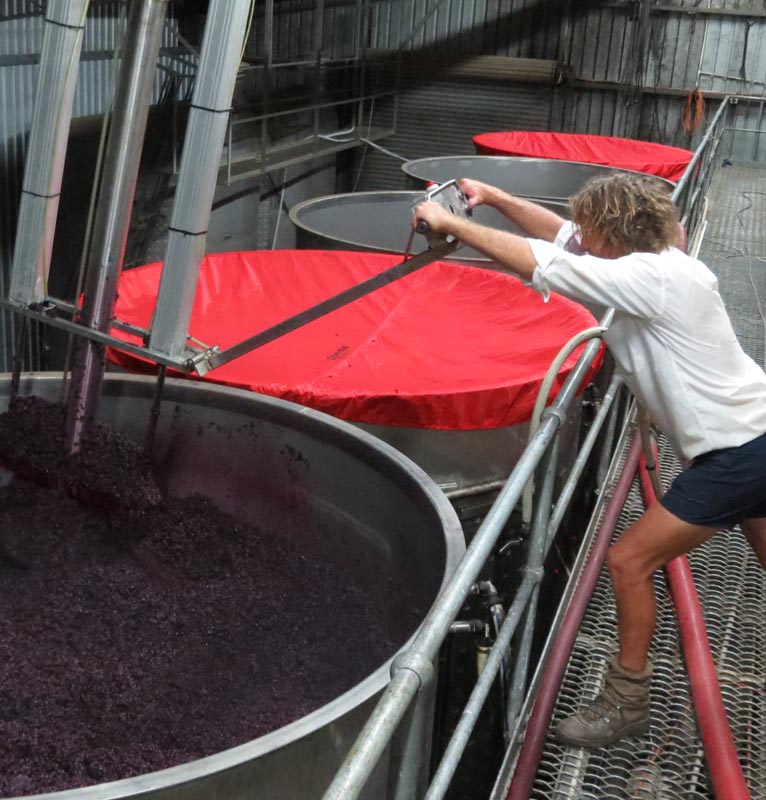WE CREATE THE WINES FOR EVERY OCCASION
ABOUT US
The release of the 2014 Shiraz marks the 40th vintage of this fine wine by Water Wheel (yes, I know: 1974–2014 is 41 years but let’s not split hairs).
Since the first Shiraz was released in 1974, we here at Water Wheel have been producing excellent, rich red wines as well as refreshing white wines.
We’re always looking at new vineyard sites and varieties, and alternative winemaking styles to keep our wines interesting and exciting.
OUR HISTORY
elimination, hibernation, resurrection.
Many great wines were made in the Bendigo area during Victoria’s boom period of the 1800’s. Sadly, some vineyards were infected with a terrible disease in the later part of the 19th century and all vineyards around Bendigo were pulled out in an effort to control its spread. This eradication included a number of vineyards at Bridgewater. General agriculture prospered all around, however there were no grapes planted here for nearly 100 years.
Fifty years ago there was a lively degree of diversity in Australian culture. Although a meat and three veg. society we could enjoy lamb one day and perhaps beef the next, then for added variety maybe swap carrots for beans on another. Still, the giant of manifest adequacy began to sway a little with the spreading availability of garlic, pizza and my personal cosmopolitan favourite: chicken chow mein. Wider interest also led to a renaissance of winemaking in Victoria. The late 1960s saw the first replanting of grapes in Bendigo in living memory. Soon after, more small vineyards sprang up around Bendigo, among them Water Wheel Vineyards in 1970, named after the nearby flour mill.
The early wines were successful for Water Wheel and the vineyards expanded. A new winery was built in 1980 to cope with additional grapes, and this is the building we continue making wine in today. 1989 saw a change of ownership with local lad Peter Cumming purchasing the winery and vineyards. With this change came modern equipment, and grapes from additional vineyards around Bridgewater.
Water Wheel is still a family business based in Bridgewater, now with a vineyard area of over 100 hectares and sales across Australia and abroad.
LOCATION, CLIMATE & SOIL
Running east west though the middle of Victoria are some hills generously called The Great Dividing Range. Not such a great geological barrier in this old, old continent, but it does mark quite a change in agriculture. Bendigo is north of The Divide where the sun shines in summer and the rain falls in winter, a region well suited to robust reds made from ripe grapes.
Bridgewater itself is 50km NW of Bendigo and 180km NW of Melbourne. We receive a bit less rainfall than Bendigo, around 425mm. (or 17 inches in the old money), not much less than many vineyard areas in Europe. But, of course, our years vary greatly and the evaporation is often 1500mm. per year (as Dororthea Mackellar wrote “A land….. Of droughts and flooding rains”). These factors combined mean that in most years our vineyards receive some irrigation from the nearby Loddon River.
With 40 years of growing grapes behind us we hope that we have a pretty good idea of which soils suit which varieties. To this end we grow our white grapes on light, well drained soils where the roots easily probe deep and wide to find nutrients and water, delivering wines with easy to reach flavours. Our red grapes are typically grown on much heavier soils with a clearly defined heavy clay subsoil. Here the red grape vines must push into the sub-soil chasing life for their fruit and bringing with it those qualities of depth and length we enjoy, but are often difficult to find.
VINEYARDS
How much dirt does it take to make a bottle of wine? Well, we have about 2,500 vines per hectare and each hectare yields 2,500 to 5,000kg of grapes, most years on the lower side (that’s 1-2T. per acre). After crushing, pressing, maturation and owner’s ongoing sampling we hope to end up with around 2,000 to 3,000 bottles per hectare. So this equals a bottle or so per vine from a patch somewhere between the size of a single and double bed. The artists amongst us might say “that’s nice” while the accountants may say “extravagant soil use”. Each, with little thought, has a claim to being right, but in any case there’s a bit more to it than this.
In common with most projects, planning and preparation are what makes a good vineyard. Over many years we’ve learnt to recognise the soils that might give us the qualities we seek. There comes a time when the chosen are called and work begins. While surveys are prepared quietly, outside there are vigorous signs of development. A bulldozer as big as a house and as strong as a train pulls a single ripper the size of a rugby player along a line where vines will soon be planted. With this preparation, the young vine’s roots are already exploring the soil 2 metres deep in their first growing year. And a few years later when the first grapes are picked the roots will have explored far deeper and wider in the soil. With luck, the wines we make will have a corresponding depth and breadth of flavour.
We’ve seen our harvest dates getting earlier and earlier, particularly in the past 10 years, to the extent that we now pick our grapes a month earlier than in the 1990s. Eight years ago our most recent vineyard was established 40 kilometres south of Bridgewater at Baringhup, near Maldon. Still by the Loddon River and still in the Bendigo region this land is halfway to The Dividing Range. Early results indicate that it is a bit cooler down there with harvest happening about 10 days later. The wines are very rewarding, having more delicate flavours that help to make a wine “whole”.
Our vineyards vary in age from 6 to 40 years old. We can see the qualities of grapes from our older vines but have never been disappointed with the crops from our new vineyards. Careful preparation means that even when the first crop is harvested, the vines are delving through a great volume of soil. The drought of last decade was hard everywhere. Some of our vines survived others did not. Twenty five years ago we could be profligate with our water, thinking it would never run out; maybe we all thought a bit that way. No longer. Our newer vineyards have drippers under the ground, the vines are further apart and what has turned out to be the most important factor in preserving moisture: the vine rows are mulched with straw. “No good getting older if you don’t get wiser” an old employee once said. I hope we are doing all things a little better than 25 years ago.

WINEMAKING
The secret of good wine is good grapes. But, you can still make a bad wine from good grapes. Wine grapes must be the sweetest fruit there is. They’re really sweet! Half as sweet again as table grapes, twice as sweet as apples and five times as sweet as tomatoes. Typical red grapes come into the winery with 25% sugar and after fermentation we wind up with a bit over half this as alcohol: about 14%. And in a fortuitous coincidence, yeast will ferment sugar into alcohol up to a concentration of about 16%.
Wine has been made for thousands of years, and the changes really aren’t that great. Yeast still make the alcohol and wine is still stored in barrels. Here at Water Wheel we follow mainstream winemaking: white grapes are pressed as whole grapes while red grapes are crushed, fermented on skins then pressed.
We’ve used cultured yeasts for years, but have lately regressed to some traditional styles of winemaking: about half of our ferments are conducted by yeast indigenous to the winery (so called “wild yeasts”). Red wines also undergo a secondary “malo-lactic” fermentation, and again this happens spontaneously with indigenous bacteria. During the fermentation of red grapes we plunge the red skins that have risen to the top back into the wine. We find this method of extraction gives us the soft, long tannins we are looking for.
Underneath the winery is a cellar capable of holding over 500 barrels. Here, away from noise and varying temperatures our wines slowly mature, it’s pretty easy to keep our barrels full and safe from oxidation. Lastly, when we’re happy with the wine, it is bottled on our own bottling line. A typical white wine is bottled at 6 to 12 months old, while reds are usually 18-24 months old. White wines are comparatively delicate and are finely filtered to bottle and might need a week or two to return to optimum drinking. Red wines are much more robust, containing the natural preservative tannin and these wines are only coarsely filtered.

